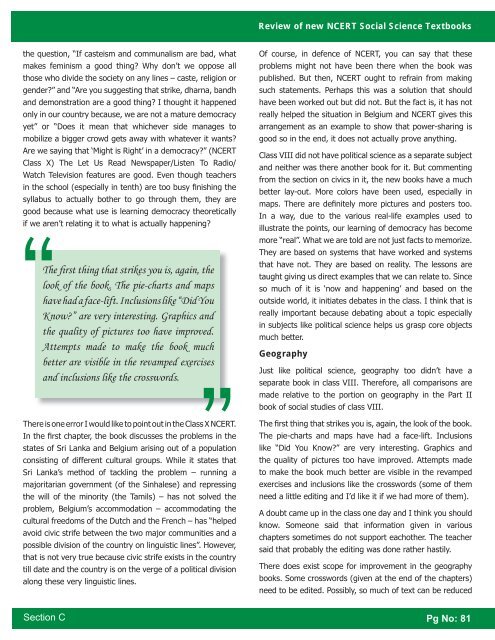Indesign Pagesnew.indd - Azim Premji Foundation
Indesign Pagesnew.indd - Azim Premji Foundation
Indesign Pagesnew.indd - Azim Premji Foundation
You also want an ePaper? Increase the reach of your titles
YUMPU automatically turns print PDFs into web optimized ePapers that Google loves.
the question, “If casteism and communalism are bad, what<br />
makes feminism a good thing? Why don’t we oppose all<br />
those who divide the society on any lines – caste, religion or<br />
gender?” and “Are you suggesting that strike, dharna, bandh<br />
and demonstration are a good thing? I thought it happened<br />
only in our country because, we are not a mature democracy<br />
yet” or “Does it mean that whichever side manages to<br />
mobilize a bigger crowd gets away with whatever it wants?<br />
Are we saying that ‘Might is Right’ in a democracy?” (NCERT<br />
Class X) The Let Us Read Newspaper/Listen To Radio/<br />
Watch Television features are good. Even though teachers<br />
in the school (especially in tenth) are too busy fi nishing the<br />
syllabus to actually bother to go through them, they are<br />
good because what use is learning democracy theoretically<br />
if we aren’t relating it to what is actually happening?<br />
The fi rst thing that strikes you is, again, the<br />
look of the book. The pie-charts and maps<br />
have had a face-lift. Inclusions like “Did You<br />
Know?” are very interesting. Graphics and<br />
the quality of pictures too have improved.<br />
Attempts made to make the book much<br />
better are visible in the revamped exercises<br />
and inclusions like the crosswords.<br />
There is one error I would like to point out in the Class X NCERT.<br />
In the fi rst chapter, the book discusses the problems in the<br />
states of Sri Lanka and Belgium arising out of a population<br />
consisting of different cultural groups. While it states that<br />
Sri Lanka’s method of tackling the problem – running a<br />
majoritarian government (of the Sinhalese) and repressing<br />
the will of the minority (the Tamils) – has not solved the<br />
problem, Belgium’s accommodation – accommodating the<br />
cultural freedoms of the Dutch and the French – has “helped<br />
avoid civic strife between the two major communities and a<br />
possible division of the country on linguistic lines”. However,<br />
that is not very true because civic strife exists in the country<br />
till date and the country is on the verge of a political division<br />
along these very linguistic lines.<br />
Section C<br />
Review of new NCERT Social Science Textbooks<br />
Of course, in defence of NCERT, you can say that these<br />
problems might not have been there when the book was<br />
published. But then, NCERT ought to refrain from making<br />
such statements. Perhaps this was a solution that should<br />
have been worked out but did not. But the fact is, it has not<br />
really helped the situation in Belgium and NCERT gives this<br />
arrangement as an example to show that power-sharing is<br />
good so in the end, it does not actually prove anything.<br />
Class VIII did not have political science as a separate subject<br />
and neither was there another book for it. But commenting<br />
from the section on civics in it, the new books have a much<br />
better lay-out. More colors have been used, especially in<br />
maps. There are defi nitely more pictures and posters too.<br />
In a way, due to the various real-life examples used to<br />
illustrate the points, our learning of democracy has become<br />
more “real”. What we are told are not just facts to memorize.<br />
They are based on systems that have worked and systems<br />
that have not. They are based on reality. The lessons are<br />
taught giving us direct examples that we can relate to. Since<br />
so much of it is ‘now and happening’ and based on the<br />
outside world, it initiates debates in the class. I think that is<br />
really important because debating about a topic especially<br />
in subjects like political science helps us grasp core objects<br />
much better.<br />
Geography<br />
Just like political science, geography too didn’t have a<br />
separate book in class VIII. Therefore, all comparisons are<br />
made relative to the portion on geography in the Part II<br />
book of social studies of class VIII.<br />
The fi rst thing that strikes you is, again, the look of the book.<br />
The pie-charts and maps have had a face-lift. Inclusions<br />
like “Did You Know?” are very interesting. Graphics and<br />
the quality of pictures too have improved. Attempts made<br />
to make the book much better are visible in the revamped<br />
exercises and inclusions like the crosswords (some of them<br />
need a little editing and I’d like it if we had more of them).<br />
A doubt came up in the class one day and I think you should<br />
know. Someone said that information given in various<br />
chapters sometimes do not support eachother. The teacher<br />
said that probably the editing was done rather hastily.<br />
There does exist scope for improvement in the geography<br />
books. Some crosswords (given at the end of the chapters)<br />
need to be edited. Possibly, so much of text can be reduced<br />
Pg No: 81

















